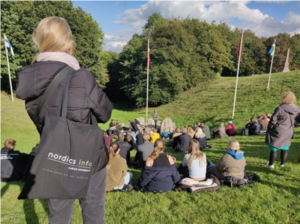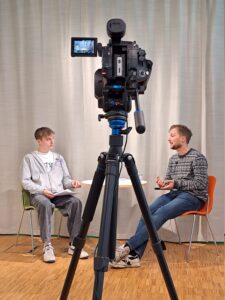Media coverage of the Nordic region is often dominated by clichés. Commercial and political branding can quickly reduce ‘Norden’ to easily understandable messages, such as ’gender-equal’, ’consensus-orientated’, ’little or no corruption’, ’green’ etc. The main purpose of the New Nordic Lexicon is to provide a more nuanced and research-based approach to the Nordic countries by giving a popular voice to researchers and to disseminate this to young people in the Nordics.
The lexicon is a collection of articles about topics within Nordic society, history, and culture. It is written by researchers, and accompanied by a series of research-based podcasts and films. It has been developed with the input of researchers and students from across the Nordic countries. Young peoples’ input has been particularly important as the main target audience is those between 16-30 years of age. In creating material for the Lexicon, students have worked with researchers in the recording of podcasts and films, and on a reference group which has fed into its development.
The idea for the lexicon sprung from my experiences with publishing accessible, academic articles on the platform nordics.info, which is based at the School of Culture and Society at Aarhus University. Nordics.info is part of the university hub Reimagining Norden in an Evolving World (ReNEW), which combines the expertise of academics within the social sciences and humanities from six universities across the Nordic region. The title ‘the New Nordic Lexicon’ seemed very apt as it reflects much of the material we have published and will publish in the future, but it can just as easily be questioned: What can be genuinely new? What does Nordic actually mean? – and what really is a lexicon? (the latter being probably of most interest to readers of Lingoblog).
New: Impossible to be entirely up-to-date

’New’ can stop being just that very quickly. It is a near-impossible task to keep lexica, dictionaries, and encyclopaedias entirely up to date, even though publishers, writers, and official language bodies might try to do so. There are three crucial aspects of how this project has tried to be ’new’:
Firstly, traditional words can of course take on new meanings and connotations in different contexts. Danish ”hygge” (cosiness) was once perhaps deemed to be entirely positive, but more critical understandings of it have been bubbling up. Immigrants who do not practice ”hygge” in the correct way can be excluded, and the word has been incorporated into aspects of life that are discriminatory (as in ”hyggehomofobi…sexisme” (cosy homophobia…sexism) and so on). On the other hand, semantic developments can be productive and useful, as in “sexual dannelse” (sexual bildung).
Secondly, what is perceived to be Nordic is often associated with the classic building blocks of the welfare state developed throughout much of the twentieth century, such as, solidarity at work, state-run, reliable institutions, trust etc. To take a new approach is not to say these aspects of the Nordic societies are not important, but the term ’new’ in the New Nordic Lexicon implies that the meanings of Nordic are more dynamic and evolving. So, while we can’t hope to be entirely ’new’, the development of traditional words and concepts into something new and modern is important and relevant.
Thirdly, the target group of the New Nordic Lexicon is young people (16-30 years). Therefore, young people were consulted about what aspects within social science and humanities research would be useful or interesting to them. Discussions were held at each of the ReNEW partner universities across the Nordic countries. Interestingly, the responses could also be put into broadly two groups: traditional perceptions of what ‘Nordicness’ is, and alternative viewpoints, often challenging these. More often than not, respondents made it clear that in mentioning classic aspects (e.g. equality), they also meant the inclusion of the exact opposite (e.g. inequality). Like researchers, these young people were at once constructing and deconstructing their ideas of what Nordic meant to them, and expressing that ’Nordic’ is a very slippery term.
Nordicness: Constructing and Deconstructing a Region
The Nordic region is usually defined as the five states: Denmark, Finland, Iceland, Norway, and Sweden and the three autonomous territories of the Faroe Islands and Greenland (Denmark), and Åland (Finland). But ’Nordicness’ is difficult to define precisely, and it is rather bewildering. The term conjures up images of particular landscapes, people who look a certain way, or societies that function a certain way. The general premise of nordics.info and ReNEW is that what Nordic means can change over time and context, depending on who is speaking and which audience they are speaking to. Peter Stadius, Research Director of the Centre for Nordic Studies in Helsinki and the academic lead for ReNEW, has said:
”What it means to be ’Nordic’ is actually quite complex. It is easy to assume that we know what it means simply by virtue of living in the Nordics, but our experience is often limited to only one or two countries or regions. Our understanding of nordicity is also greatly influenced by how the surrounding world sees us…”

It appears, then, to be a flexible concept, changing its meaning, which makes it difficult to pin down and understand. This fluidity can be seen as being at odds with what many people expect from research dissemination, that is, clarity and certainty in a world of too much information and fake news. For better or worse, academic literature is difficult to navigate and clarity and certainty cannot always be provided by scholars. Each academic field has different methodologies and perspectives, and each new research paper finds out something new and unique – and possibly contradictory – to those that have gone before. Part of research dissemination should also be to make this clear and allow the reader the scope to decide for themselves.
The reason why regional approaches are particularly significant is that many other narratives are dominated by national stories or interpretations. Looking beyond national borders can be revealing. In conversations with people from the same country, it is assumed that you all have particular understandings of words, phrases, and concepts, and things do not have to be spelt out. But when other nationalities – or even people from a different area or background within the same country – are involved in the conversation, comparisons and misunderstandings can be illuminating: We learn about ourselves and our own use of language and assumptions. This lends itself to revealing cross-cultural comparisons of apparently simple terms ’Welfare’ has very different connotations in the US than it has in the Nordics, or the German ’Volk’ compared to the Scandinavian ’folk’, for example. These comparisons of course exist within the Nordic countries: What seems Nordic to someone from Svalbard may be quite different from what seems Nordic to a Dane, to someone who immigrated to Iceland in 1980s, or to a newly arrived refugee etc. Some are strongly averse to the term and prefer alternatives for their region as they see it (such as the Arctic), some don’t think about it at all.
Translation Challenges
The languages found in the Nordic countries are diverse, coming from different language families with varying legal and cultural status. Many terms within these languages – like any other language – are difficult to translate into another language, and it is unsurprising that the sociopolitical baggage of a word cannot be conveyed in a translation of words only. This was reflected in the consultation with some predictable and less predictable terms being suggested, which some saw as typically Nordic – or Finnish, Greenlandic, Swedish etc.

Articles for the New Nordic Lexicon are all in English and each article is translated into one other Nordic language. Our intention is to show the variety and breadth of the Nordic languages. This process has led to some interesting challenges. It proved impossible to find a Meänkieli translator, for example. In our article ‘Racialization in Nordic Schooling’ in English, you find the terms “race” and ”racial”. When getting it translated into Finnish, it became apparent that these terms are not commonly used in Finnish public discourse and research without e.g. quotation marks in order to avoid the meaning of race as “a fact” or attaching to right-wing populist discourses. Therefore, alternatives had to be found.
Another challenge was that the terms from the three Scandinavian languages could not quite capture the meaning of ”access to justice” in English. ‘Retfærdighed’ or ‘rättvisa’ (simply ‘justice’ in Danish or Swedish) does not quite convey everything the broader term ‘access to justice’ includes, so it was actually referred to in the Swedish version of the article in English. Conversely, ‘retsstaten’ or ‘rättsstatsprincipen’ is difficult to translate directly into English, while the principles lying behind these terms are usually captured in English by the term ‘rule of law’.
There are three articles translated into Faroese. One called “Childcare infrastructure in the Nordic Countries” (or “Barnaansingar- og barsilsskipanir í Norðurlondunum”) points out how systems surrounding paid parental leave and universal childcare are necessary for the functioning of society, just like what we would normally refer to as infrastructure, namely, roads, power supplies and so on. Despite this, the word ‘infrastructure’ in Faroese (undirstøðukervið) did not really work and was replaced with something more akin to a ‘system’ (skipan). Additionally, many academic terms are referred to or explained throughout the Lexicon. Due to the history of the Faroese language and that of the Faroe Islands, Faroese as an academic language is still developing, and consequently some academic terms can jar more in Faroese than in other languages, where they are more widely used. If a word seems unnatural, it can be a particular challenge for translators seeking to be absolutely precise.
In the table below, you can see some of the words suggested as part of the consultation grouped under society, history, and culture for practical reasons – although many of them could be placed under all three headings as well as others. They could also have been placed under the banner of a national language or/and Nordicness, as this is also often rather fluid. (Please note that the wider consultation was not just about individual words, and an overview of the other results can be seen online here: What is important to young people in the Nordic region?)
| Society | History | Culture |
| Childhood | Arctic coloniality* | Empathy |
| Dannelse (educational formation/bildung) | Baltic* | Faroese literature and society* |
| Digital literacy | Cooperation (in relation to working together generally, Samarbete/samverkan) | Flightshame/Oilshame |
| Dugnad (A type of voluntary work, in Norwegian) | Cooperation (between the Nordic countries) | Folkelighed (‘Peopleness’ in the Scandinavian languages) |
| Folkhemmet (The People’s Home, in the Scandinavian languages) | Folkestyre (A system of ruling where the people have power, in Danish) | Fredagsmys |
| Gender | Lutherdom | Friluftsliv (‘Life in the fresh air’ in the Scandinavian languages) |
| Sila (Weather, soul, land/ice/sea, in Greenlandic) | Norden | Intangible cultural heritage |
| Gulahallat (To communicate/understand one another, in Sámi) | Peace | Janteloven/jantelag (’law’ of attitude towards achievements in the Scandinavian languages) |
| Humour | Royalty | Kulturarv (Cultural heritage) |
| Hyggehomofobi (Everyday homophobia, in Danish) | Scandinavianism* | Kvæði (Heroic ballads in Faroese) |
| (U)Hygge (Cosiness or absence of it, in Danish) | Viking(s) | Maaemo (Mother Earth in Finnish) |
| Kulturkristen (’Culture Christian’, in Danish) | Nature | |
| Lagom (Just the right amount, in Swedish) | Nordic noir | |
| Lykke (Happiness in Danish) | Nærvær/fravær (Intimacy/presence and absence in Danish) | |
| Tryghed (Security/safety, in the Scandinavian languages) | Solidarity | |
| Petrocultures | Stereotypes | |
| Racism | Trust | |
| Universal welfare state | Tjóðskapur (National belonging in Faroese) | |
| (Social) Welfare | ||
| Links are to articles and sometime theme pages on nordics.info as well as the New Nordic Lexicon. *Material in the pipeline at the time of publishing this article. See more on the consultation for the New Nordic Lexicon here. | ||
Research Dissemination through the New Nordic Lexicon
The focus of each contribution for the New Nordic Lexicon depends on the area of the author’s research, rather than etymology and linguistic aspects like you may find in a traditional lexicon. A traditional lexicon is, according to the Online Oxford English Dictionary, a ”word-book or dictionary” or ”The vocabulary proper to some department of knowledge or sphere of activity; the vocabulary or word-stock of a region, a particular speaker, etc”, and is usually associated with the subject of linguistics. The New Nordic Lexicon does not fit comfortably within this definition and was influenced by the terms “leksikon” (which is often translated into English as ‘encyclopaedia’ or similar), and “leksikonartikler”, such as those found on our sister websites danmarkshistorien.dk and norgeshistorie.no. So, while the name is inspired by all of the strands mentioned here, it is most important that the Lexicon aims to give a popular voice to researchers and to disseminate this to young people in the Nordics. This aim is perhaps explained best by one of our volunteers when she spoke about reducing the gap between scholars and young people:
“Even though everything in itself is quite interesting and relevant when it comes to researchers’ work, I find there’s a lack of getting that information to the general public and especially young people – it’s often the language used alone that makes it hard for younger people to grasp what researchers are referring to” (Student volunteer for the New Nordic Lexicon)
The New Nordic Lexicon is supported by the A.P. Moller Foundation and ReNEW is supported by NordForsk and has six partner universities (Aarhus, Södertörn, Iceland, Oslo, Helsinki and Copenhagen Business School).
Thank you to those who provided input for this article, particularly the translators for the New Nordic Lexicon.
Nicola Witcombe is the editor of nordics.info and Project Manager of the New Nordic Lexicon.






